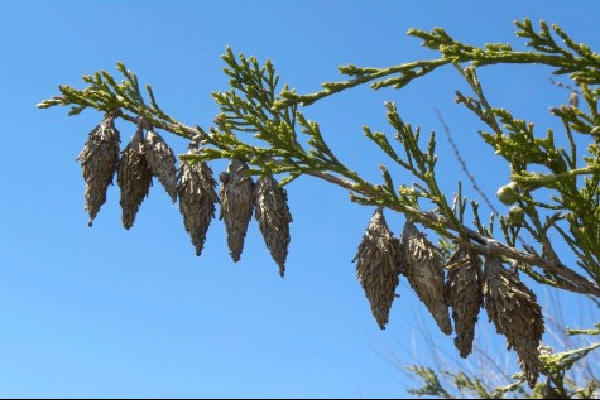If your landscape has a history of bagworm problems, it’s time to start looking for them.
Nebraska Extension entomologist Jonathan Larson says “Bagworms are some of the best architects in the insect world. These caterpillars take materials from the plants they live in and construct a tough bag to dwell in as they grow.”
 Fully grown bagworms on a juniper shrub. Image by Jim Kalisch, University of Nebraska Entomology.
Fully grown bagworms on a juniper shrub. Image by Jim Kalisch, University of Nebraska Entomology. The insects and their cocoons can be hard for gardeners to spot since they look so much like a natural part of the plant. Last year’s cocoons are easier to spot than the tiny structures made by new insects. Many people don’t realize the pointed oval structures the insects create and carry around with them aren’t a natural part of the tree.
Bagworms are native to the United States and common in eastern Nebraska. They feed on many species of trees and shrubs, but are most damaging on evergreen trees and shrubs. Juniper, arborvitae, pine, and spruce branches may be killed if completely defoliated. Entire plants can be killed if an infestation goes uncontrolled for several years, although usually bagworm infestations build up slowly over two or three years.
Bagworms also feed on shade, orchard, and forest trees of nearly every kind, as well as many ornamental shrubs and perennials, however severe attacks are unusual. Since deciduous plants regrow new leaves each year, the defoliation caused by bagworm feeding is not a serious problem for the plant. However, the growth of small or newly planted trees could be slowed by heavy leaf feeding.
Bagworm Identification and Lifecycle
After overwintering as eggs inside the female’s old bag, a new generation of insects begins hatching in late May and early June. The larvae are tiny brown or tan caterpillars with black markings and feed all summer.
After hatching, the larvae emerge from a hole at the base of the mother’s bag and spin down a strand of silk. The tiny insect is often ballooned by the wind to nearby branches or plants. Once a suitable host is found the young insect immediately begins to form a new bag over its body to protect itself from predators. Initially the young insect’s bag is about 1/8 inch long, but the bag is continually enlarged as the insect grows until is measures about 2 inches long when the insect is mature.
The adult male bagworm is a small, furry gray moth with clear wings; the adult female does not have wings and never leaves the bag she constructs during feeding. By mid-August the mature larvae attach their bag to a branch with a strong band of silk and begin to pupate. Adult males emerge in September.
There may be as many as 200-300 eggs in a single female’s bag. Since the female bagworm cannot fly, local populations can build up to damaging levels as succeeding generations of insects emerge over the course of several years, but there is only one generation per year.
Control
How can bagworms be controlled? Handpicking the old cocoons is the best way to control light infestations on small plants. Be sure to remove the bags before eggs begin to hatch in late May. Destroy bags by burning, immersing them in kerosene or by crushing. If bags containing eggs are discarded on the ground, the larvae will still hatch and may find their way back to your landscape plants.
Otherwise, plan to apply an insecticide to control this year’s small larvae in late June. Bacillus thuringiensis, BT, is available at nurseries and garden centers as Dipel or Thuricide. It’s very effective at controlling the insects without damaging other beneficial insects. It also has very low toxicity to birds and mammals.
Other insecticides labeled for bagworm control include bifenthrin, cyfluthrin and permethrin. Affected plants must be thoroughly covered with the insecticide so it is ingested by the insects as they feed.

